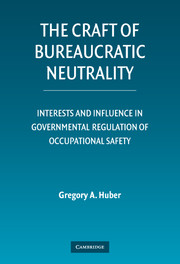 The Craft of Bureaucratic Neutrality
The Craft of Bureaucratic Neutrality 3 - From Regulatory Search to Enforcement
Published online by Cambridge University Press: 27 July 2009
Summary
The previous chapter argued that OSHA's leadership has chosena strategically neutral enforcement posture. But actual enforcement in thefield, seeking out and punishing those who violate the law, may differ substantially from this ideal vision proffered by agency leaders in Washington. This chapter examines OSHA's field enforcement program from start to finish, considering separately OSHA's deployment of resources (staffing of regions and local offices), search for violators (inspection targeting and inspector productivity), and punitiveness. Thus, it takes an “inside the agency” look at how agency leaders attempt to structure and manage the agency's field enforcement efforts, successfully or not, in order to secure their larger political goals.
An additional motivation for this inquiry is to reconcile the arguments made in Chapter 2 about OSHA's geographic neutrality with previous scholarship that portrays OSHA's field enforcement efforts as heavily affected by a variety of local political concerns – the preferences of locally elected members of Congress, business and labor advocacy group strength, and local constituency preferences (Scholz and Wei 1986; Scholz, Twombly, and Headrick 1991). These arguments are hard to dismiss given the aggregate association between state-level politics and OSHA's enforcement efforts. For example, there is a strong positive correlation between statewide Democratic Party support and OSHA's enforcement efforts. Table 3.1 shows that in states where support for Clinton was greater in the 1992 presidential election, OSHA inspected a larger proportion of businesses than in states where Bush did better.
- Type
- Chapter
- Information
- The Craft of Bureaucratic NeutralityInterests and Influence in Governmental Regulation of Occupational Safety, pp. 95 - 171Publisher: Cambridge University PressPrint publication year: 2007
